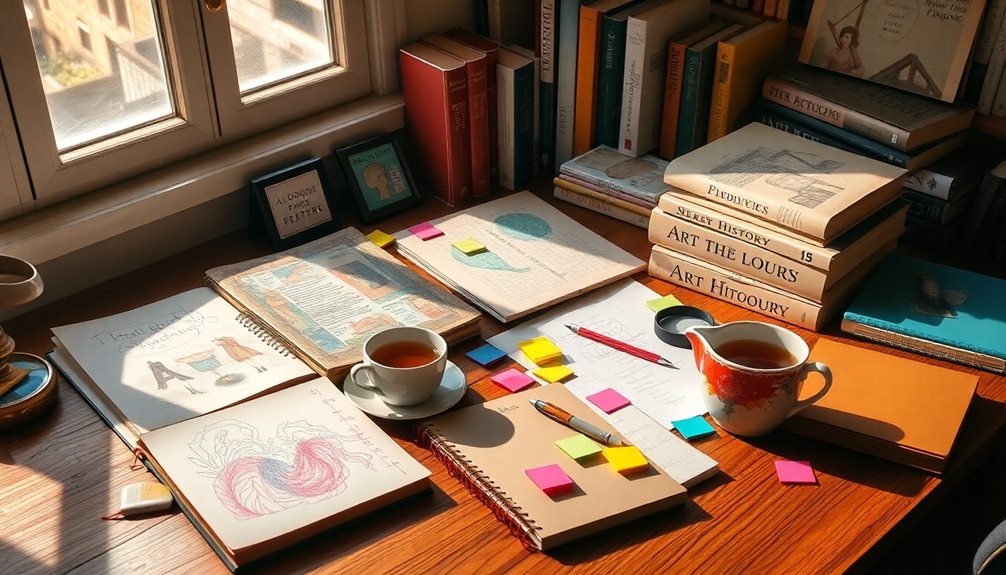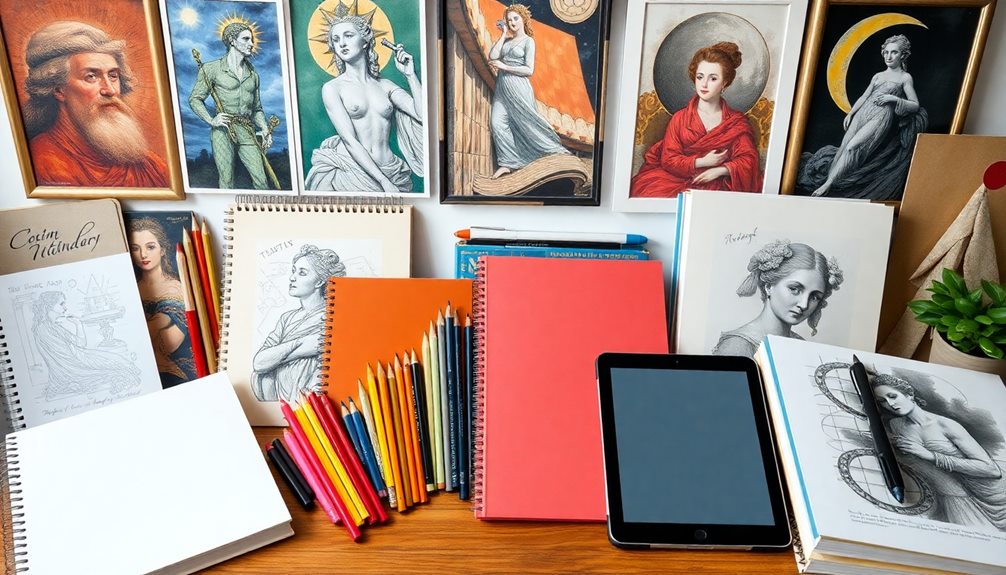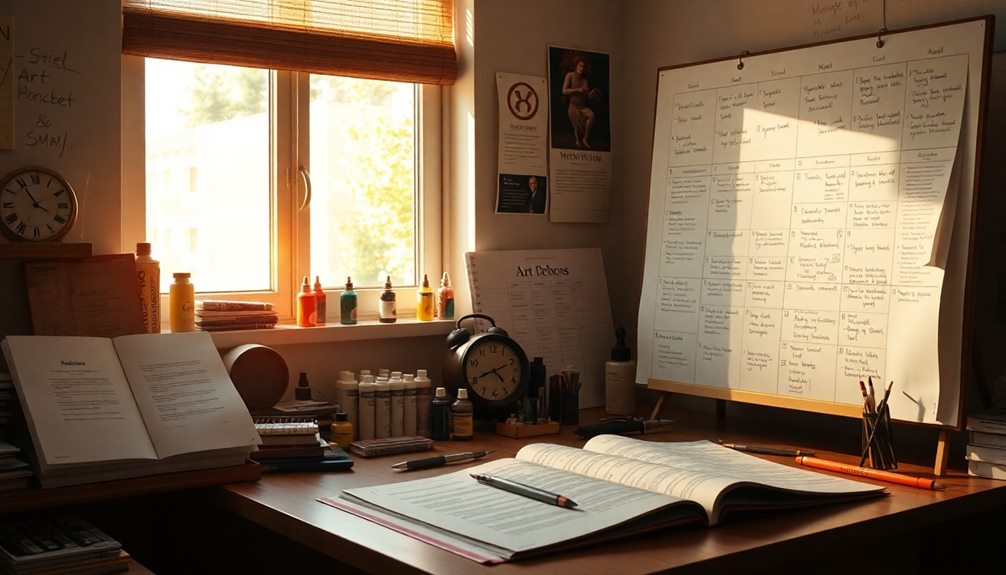To master art history, you need effective note-taking methods that boost retention and understanding. The Cornell Method helps by organizing notes into key points and summaries, while the Outline Method structures information hierarchically for clarity. You might also find the Mapping Method useful, as it visually connects ideas and themes. If you're focused on comparing artworks, try the Charting Method for a systematic approach. For richer engagement, consider incorporating sketches or color coding in your notes. Each technique offers unique benefits that can transform your study sessions for art history, leading to deeper insights and connections as you explore further.
Key Takeaways
- Utilize the Cornell Method to enhance engagement and facilitate easy review of complex art history topics.
- Employ the Outline Method for hierarchical organization, helping identify main ideas and supporting details effectively.
- Use the Mapping Method for a visual representation of relationships, allowing for better memory retention and clarity.
- The Charting Method aids in systematic comparison of artworks, highlighting similarities and differences in formal elements and themes.
- Incorporate visual elements in notes, such as sketches and diagrams, to enhance understanding and retention of art history concepts.
Importance of Effective Note-Taking

Effective note-taking is like a sturdy bridge that connects you to the intricate world of art history. By engaging in effective note-taking, you enhance your retention and understanding of complex materials, capturing important details that textbooks might overlook.
Organized notes enable you to identify knowledge gaps, making your study efforts more focused and efficient as you prepare for exams and essays.
When you summarize lecture content and key themes, you actively engage with the material, which strengthens your comprehension. Incorporating visual elements, like sketches and diagrams, alongside your written notes can notably aid memory retention and deepen your grasp of artistic concepts.
These visuals provide context that text alone might miss, allowing you to see the connections between different works of art.
Regularly reviewing and updating your notes reinforces long-term retention, ensuring you build a solid foundation in art history. This proactive approach not only keeps important details fresh in your mind but also fosters a deeper understanding over time.
Enhancing Critical Thinking Skills

When you analyze art movements, you not only grasp their unique characteristics but also uncover the historical contexts that shaped them.
This process encourages you to connect different styles and periods, enhancing your critical thinking skills.
Analyzing Art Movements
Understanding art movements isn't just about memorizing names and dates; it's a critical exercise in analyzing the historical and social contexts that shaped them. As you explore your art history notes, focus on the influences that define each movement. Examine key figures and their contributions, like how the Renaissance set the stage for later styles.
When you compare and contrast movements such as Impressionism and Cubism, look for distinct techniques and philosophies. For instance, consider how Impressionism uses light and color to evoke emotion, while Cubism breaks down forms into abstract shapes. This analytical approach reveals patterns in artistic evolution, like how Abstract Expressionism arose as a response to earlier constraints.
Furthermore, don't forget to evaluate the societal and political implications of these movements. Dadaism, for example, challenged traditional aesthetics in reaction to the horrors of World War I.
Engaging with primary sources, like artist manifestos and critiques, can deepen your understanding, providing insight into the intentions behind the art. By applying these analytical skills, you'll enhance your critical thinking and appreciation for the rich tapestry of art history.
Identifying Historical Contexts
Art history's richness comes alive when you recognize the historical contexts that influenced each piece. Understanding the social, political, and cultural factors surrounding an artwork enhances your critical analysis of its meaning.
For instance, examining the patronage of the Medici family reveals how their support for artists like Botticelli reflected the societal values of the Renaissance.
By analyzing the evolution of artistic styles in response to historical events, you foster a deeper comprehension of art movements. Recognizing how the Renaissance sparked individual expression and classical themes helps you appreciate the art's significance beyond its surface.
Moreover, consider the historical significance of various art forms, such as African tribal masks. These masks played essential roles in ritual practices, offering insights into their cultural importance that goes beyond mere aesthetics.
Incorporating timelines of significant historical events alongside artworks in your notes can clarify the chronological relationship between art and the broader historical narrative.
This approach facilitates comparative analysis, allowing you to draw connections between different artworks and their contexts, ultimately enhancing your understanding of art history.
Overview of Note-Taking Methods

When it comes to note-taking in art history, you'll find various techniques that cater to different learning styles.
Adapting these methods for your lectures can enhance your understanding and retention of complex information.
Let's explore some effective strategies that can help you organize your notes more efficiently.
Various Note-Taking Techniques
Taking effective notes can transform your study of art history, making complex concepts more accessible and engaging. Here's an overview of various note-taking methods you can use in your art history class:
| Note-Taking Method | Description | Best Used For |
|---|---|---|
| Cornell Method | Divides the page into two columns for main ideas and summaries. | Organizing and reviewing key concepts. |
| Outline Method | Structures notes hierarchically, breaking broad topics into specific details. | Understanding complex art movements or themes. |
| Mapping Method | Visually represents relationships between ideas. | Capturing connections between artworks and historical contexts. |
| Charting Method | Utilizes tables for comparative analysis. | Examining similarities and differences between artists, styles, or periods. |
| Sentence Method | Focuses on writing complete sentences for clarity. | Capturing detailed descriptions and interpretations during lectures. |
Adapting Methods for Lectures
Effective note-taking methods can greatly enhance your understanding during art history lectures. Each method serves a unique purpose and can be adapted based on the lecture style and content.
For instance, the Cornell Method allows you to divide your notes into main ideas and summaries, promoting active engagement and easy review. If you prefer a structured approach, the Outline Method can help you organize broad concepts into subtopics, making it easier to follow the lecture's flow.
Alternatively, the Mapping Method visually represents relationships between various art movements or historical contexts, helping you see connections clearly. If you're comparing different artworks or artists, the Charting Method can be particularly useful, as it organizes information in tables for quick reference during discussions.
The Cornell Method Explained

Utilizing the Cornell Method can transform your note-taking experience in art history. This method divides your page into three sections: a narrow left column for keywords or questions, a wider right column for detailed notes, and a summary section at the bottom. By organizing your notes this way, you engage actively during lectures. Write questions in the left column that correspond to the detailed information in the right column, prompting deeper understanding.
After the lecture, you'll find it helpful to review your notes by covering the right column and using the keywords in the left column to recall the information. This process enhances retention and helps solidify your grasp of complex concepts. The structured format aids in organizing information logically, making it easier to study later, especially when preparing for exams and essays in art history.
The summary section at the bottom serves as a quick reference to the main ideas covered in your notes. This feature makes revision more efficient, allowing you to comprehend key art concepts without sifting through all your detailed notes.
Embrace the Cornell Method for a more effective and organized approach to your art history studies!
The Outline Method Explained

The Outline Method helps you structure information in a clear hierarchy, making it easier to identify main ideas.
By organizing your notes with headings and sub-points, you can enhance your study sessions and quickly find important details.
This method is especially useful in art history, where understanding relationships between concepts is key.
Structure and Hierarchy
Organizing your notes with the Outline Method can transform your understanding of art history by creating a clear structure and hierarchy. This method helps you categorize broad concepts, like artistic movements, into main topics represented by Roman numerals (I, II, III). You can then use capital letters (A, B, C) for subtopics, and further details can be denoted by Arabic numerals (1, 2, 3).
This structured approach not only clarifies relationships between ideas but also makes it easier to digest complex information. As you summarize information, aim to condense materials into key points while preserving the logical flow of topics.
This technique is particularly effective in art history, as it allows you to compare styles, artists, and specific works, enhancing your thematic analysis. By consistently using indentation and formatting, you enhance visual clarity, making it quicker to locate specific details during study sessions.
This organization reinforces retention and comprehension, ensuring that when you revisit your notes, you can efficiently grasp the essential elements of art history. The Outline Method truly aids in transforming your notes into a powerful study tool.
Main Ideas Identification
How can you effectively pinpoint main ideas in art history? One of the best note-taking methods for this purpose is the Outline Method. This technique allows you to organize information hierarchically, breaking down broad concepts into specific subtopics. It enhances clarity and structure, making it easier to identify key details.
Here are some key features of the Outline Method:
- Main ideas are listed as Roman numerals (I, II, III) for quick reference.
- Supporting details and examples are indented beneath each main point, promoting easy navigation.
- You can capture essential information like artist names, artwork titles, mediums, and historical context.
- Visual elements, such as sketches or diagrams, can be incorporated to suit various learning styles.
Using the Outline Method not only helps you identify relationships between different art movements and artists but also facilitates a deeper understanding of thematic connections in art history.
Enhancing Study Sessions
While studying art history, employing the Outline Method can greatly enhance your sessions by providing a clear structure to complex material. This note-taking method organizes information hierarchically, making it easier for you to identify main ideas and supporting details. By using Roman numerals for main topics, capital letters for subtopics, and numbers for further details, you create a visual map of relationships between various concepts and artworks.
This structured format allows for easy navigation through layers of content, which is particularly useful when tackling intricate themes in art history. As you summarize and synthesize information while outlining, you engage in critical thinking, reinforcing your understanding and retention of the subject matter.
Regularly revisiting and updating your outline with new insights or additional artworks keeps the material fresh in your mind, making it an effective study tool. This method not only aids in organizing thoughts but also promotes active engagement, ensuring that you're not just passively absorbing information.
The Mapping Method Explained

The Mapping Method stands out as a powerful visual note-taking technique that can transform your approach to studying art history. By organizing information in a diagrammatic format, this method helps you see relationships between concepts more clearly. You start with a central idea in the middle of the page, then branch out to subtopics and supporting details, creating a hierarchical structure that makes complex information digestible.
Here are some benefits of using the mapping method for art history:
- Visual Engagement: Incorporate colors and images to enhance memory retention.
- Clear Relationships: Easily illustrate connections between different art movements and artists.
- Flexible Structure: Adapt the layout to fit your personal learning style and preferences.
- Effective Review Tool: Simplify exam preparation and essay writing with a clear visual reference.
Using the Mapping Method, you'll actively engage with the material, making it easier to recall information when it matters most. Whether you're studying for a test or drafting an essay, this technique can be invaluable for mastering the intricate connections within art history.
Organizing Art History Notes

Effective organization of art history notes can considerably enhance your study experience and comprehension. Start by color-coding your notes by topic, period, or medium. This visual organization helps you quickly locate specific information when studying.
Additionally, consider utilizing symbols or shorthand in your notes. This saves time and space, allowing you to record details more efficiently during lectures.
At the end of each set of notes, create concise summaries to reinforce the main themes and notable artworks discussed. Summarizing aids in long-term retention and understanding of the material. Regularly revisiting and updating your notes keeps the information fresh and helps identify areas that might need further clarification or study.
Moreover, organizing your notes in structured formats like outlines or mind maps can greatly improve your comprehension. These methods facilitate easy reference and help you see the relationships between different art movements and historical contexts.
Reviewing and Summarizing Techniques

Mastering the art of reviewing and summarizing your notes is essential for retaining the wealth of information covered in art history classes. Regularly revisiting your notes can help reinforce key themes and concepts, making it easier to recall details when needed.
Additionally, practicing mindfulness during your study sessions can enhance focus and retention, allowing you to absorb the material more effectively self-care techniques.
Here are some effective techniques to enhance your reviewing and summarizing processes:
- Summarize notes after each lecture to consolidate your understanding.
- Create visual summaries like mind maps or diagrams to illustrate relationships between artworks and contexts.
- Use color-coding for different topics or periods to improve organizational clarity.
- Schedule periodic reviews, ideally weekly, to keep the information fresh.
Incorporating Visual Elements

Engaging with your notes visually can greatly enhance your understanding of art history. Incorporating visual elements, like sketches of artworks, allows you to connect details with specific images, reinforcing your memory.
When you create diagrams and mind maps, you visually represent relationships between concepts, making complex connections much easier to grasp.
Consider annotating images with significant details and context. This practice not only enriches your understanding of the artwork but also highlights its historical relevance.
Combining verbal notes with visual aids, such as charts or timelines, caters to different learning styles and boosts your overall comprehension of the material.
Regularly updating your visual notes is essential. Include new insights from lectures or readings to deepen your understanding and keep the information fresh for future reference.
This continuous engagement with visual elements won't only enhance your retention but also make your study sessions more enjoyable and interactive.
By actively integrating these strategies into your note-taking, you'll find that you develop a richer, more nuanced appreciation of art history.
Adapting Techniques for Different Styles

Adapting note-taking techniques to suit different learning styles can greatly enhance your grasp of art history. By recognizing your preferred learning style, you can choose the most effective note-taking methods to capture essential information. Here are some strategies to contemplate:
- Visual learners: Incorporate sketching and diagrams alongside traditional notes to better remember key artwork details. Engaging in creative activities, such as STEM toys that enhance creativity, can further stimulate your visual memory and artistic expression.
- Comparative analysis: Use the Charting Method for systematically organizing and comparing multiple artworks based on formal elements and themes.
- Complex concepts: Apply the Sentence Method for taking notes on intricate historical contexts, as complete sentences help guarantee thorough understanding.
- Flexibility: Don't hesitate to switch methods based on the lecture's focus, whether it emphasizes visual analysis or critical discussion.
Art history is rich and varied, so using these adaptable note-taking techniques will help you engage with the material more deeply.
Experiment with different methods to find what resonates with you, and be proactive in tailoring your approach. This way, you'll not only enhance your learning experience but also strengthen your appreciation for the intricate narratives behind each artwork.
Frequently Asked Questions
How to Take Notes for Art History?
To take notes for art history, focus on main ideas and details. Use sketches to enhance understanding, capture essential information like artist and medium, and regularly review your notes to strengthen retention and clarify concepts.
What Is the Method Used in Art History?
Think of a painter's palette; each method in art history helps you blend ideas. You'll find techniques like Cornell, Outline, Mapping, Charting, and Sentence methods enhance your understanding and retention of complex concepts beautifully.
How Do You Take Historical Notes?
To take historical notes effectively, you'll want to organize your thoughts clearly, capture essential details, and regularly review your notes. Use visual timelines and highlight significant events to deepen your understanding and retention.
What Writing Style Does Art History Use?
When it comes to art history, you've gotta know the ropes. You'll find it employs a formal, analytical style, using precise language and specific terminology, supported by citations and visual evidence to strengthen your arguments.
Conclusion
In the vibrant tapestry of art history, effective note-taking is your brush, helping you paint a clearer picture of the past. By weaving together critical thinking and diverse methods, you create a masterpiece of understanding. Remember, your notes aren't just words; they're stepping stones on your journey through time and creativity. Embrace the techniques that resonate with you, and let your insights shine like brushstrokes on canvas, illuminating the rich stories behind every piece of art.









